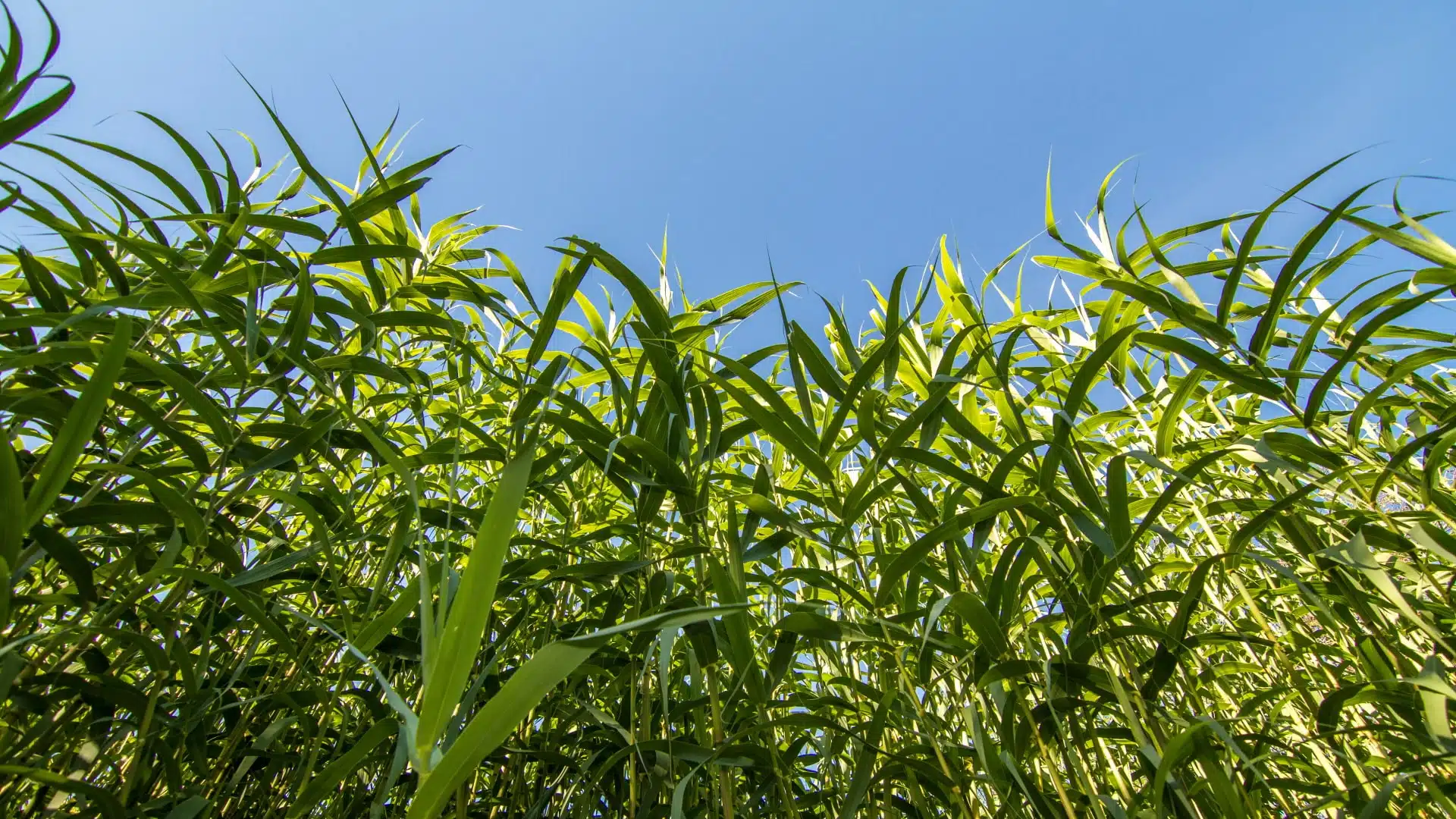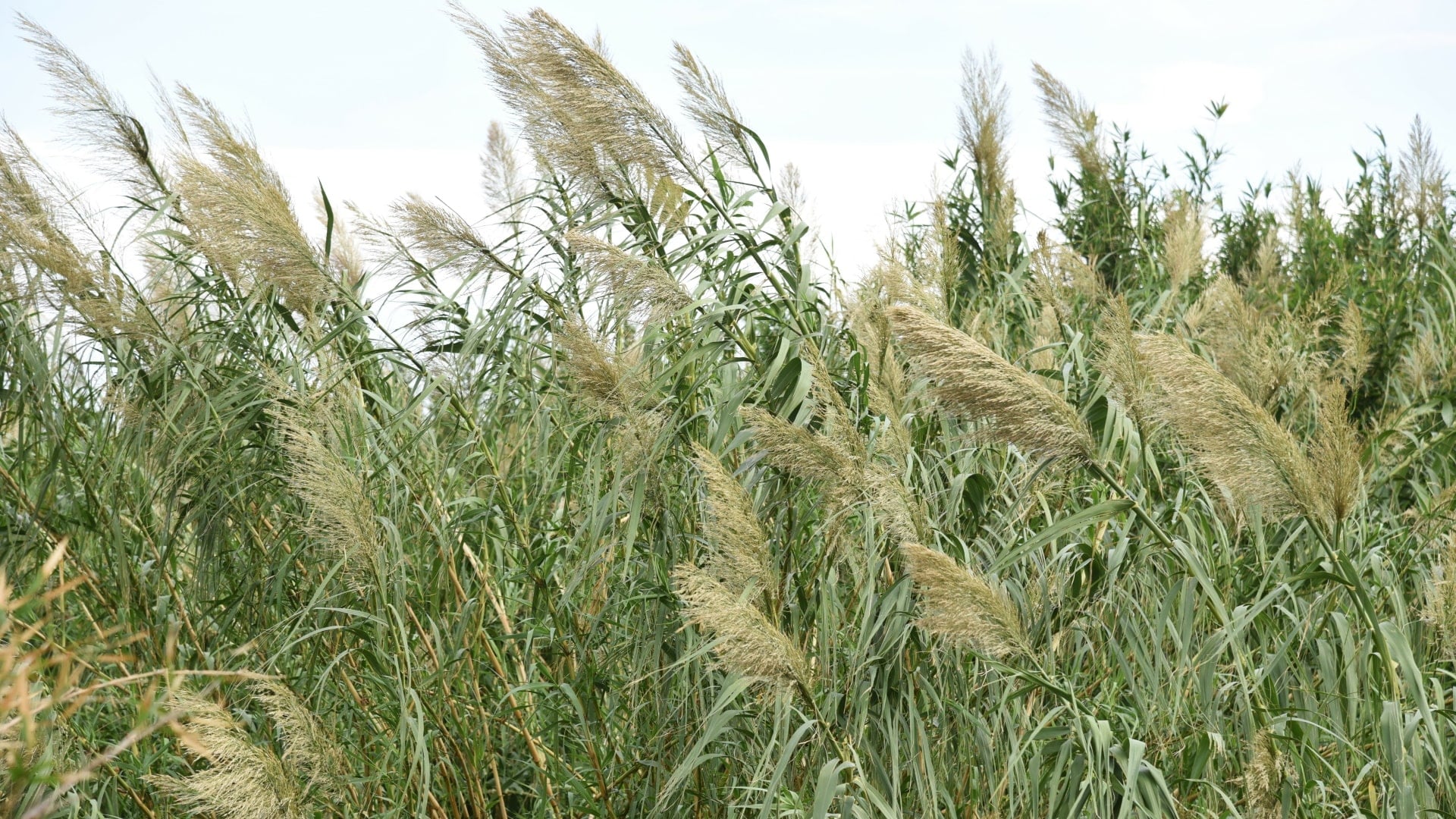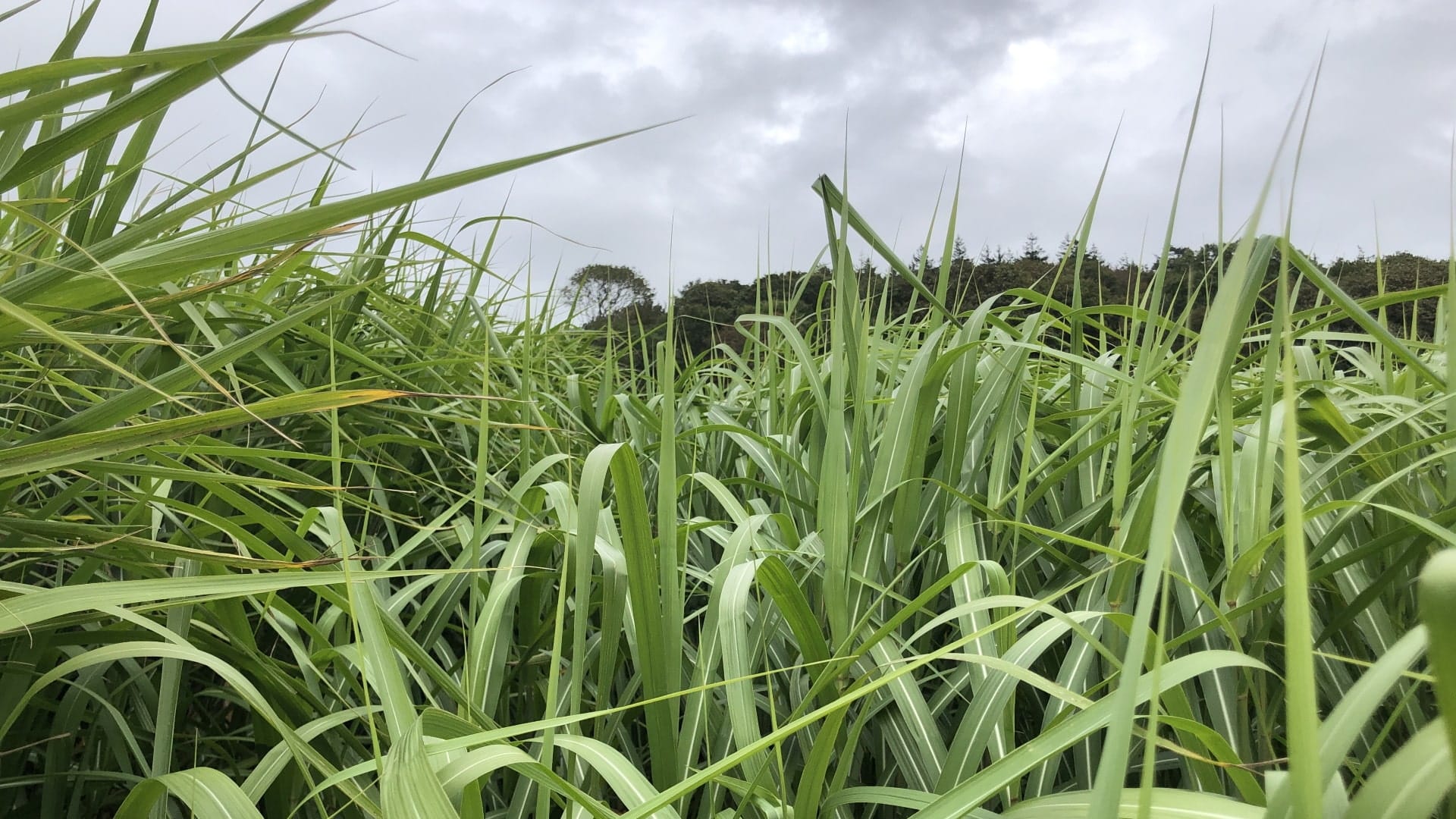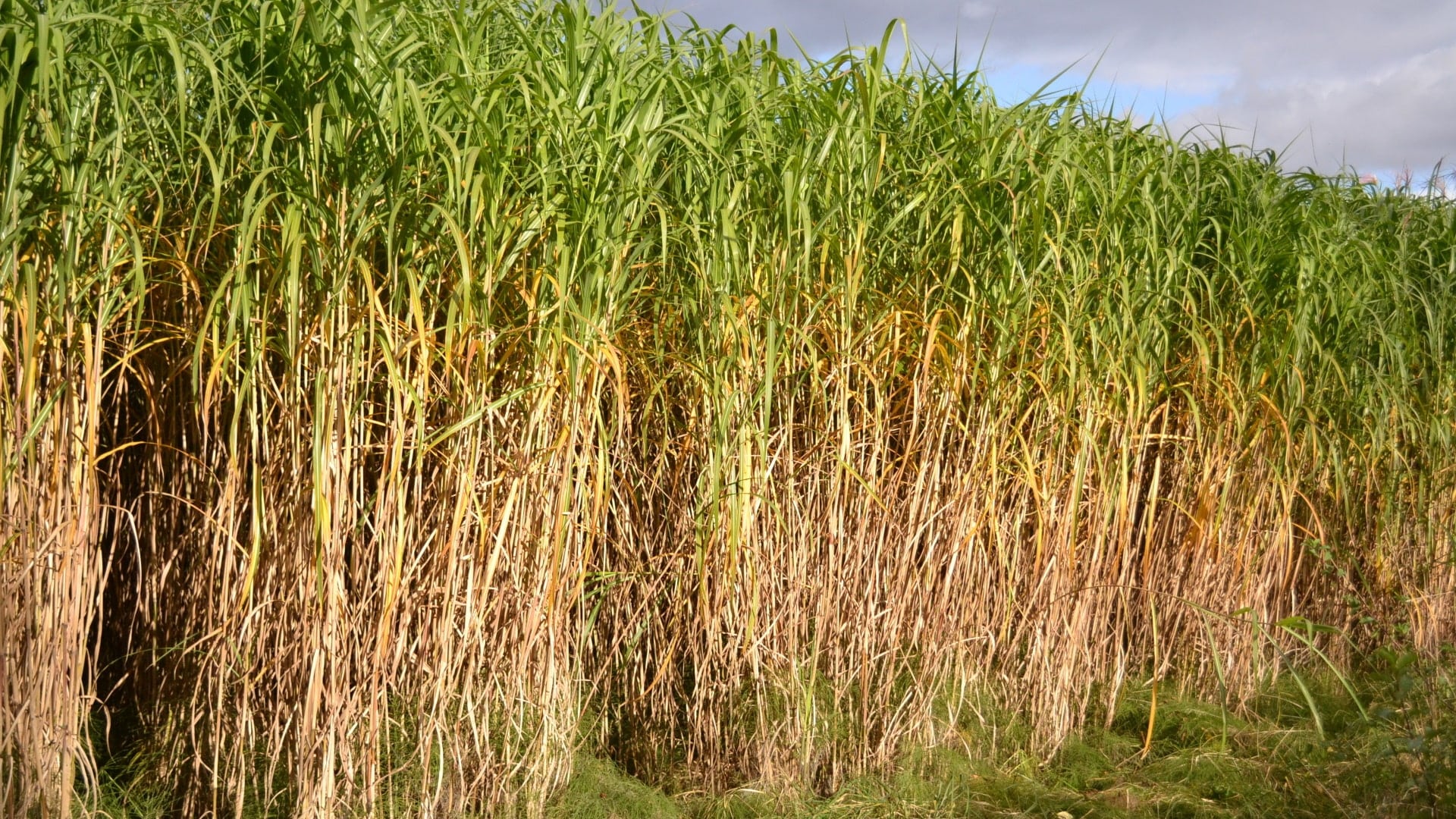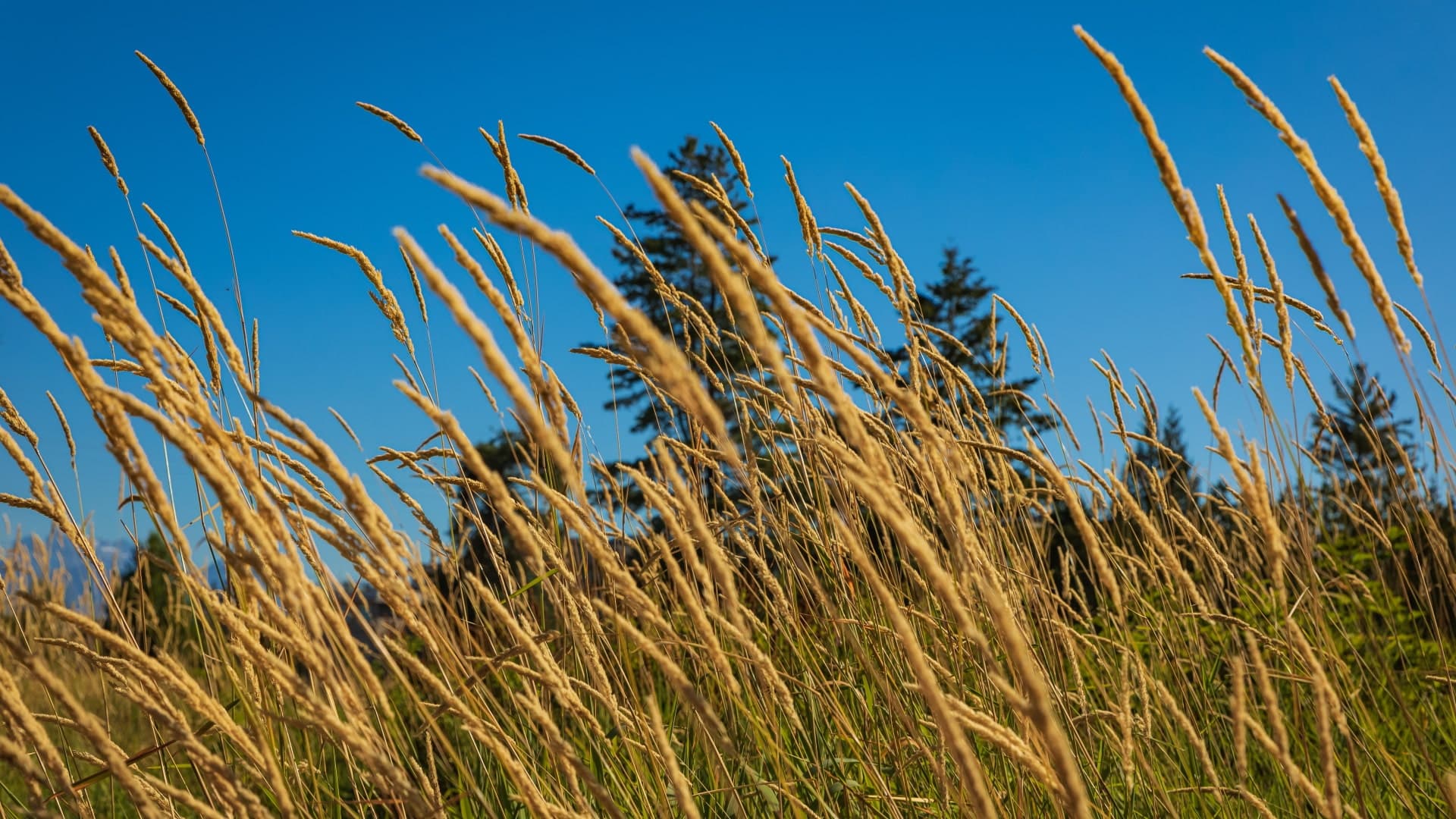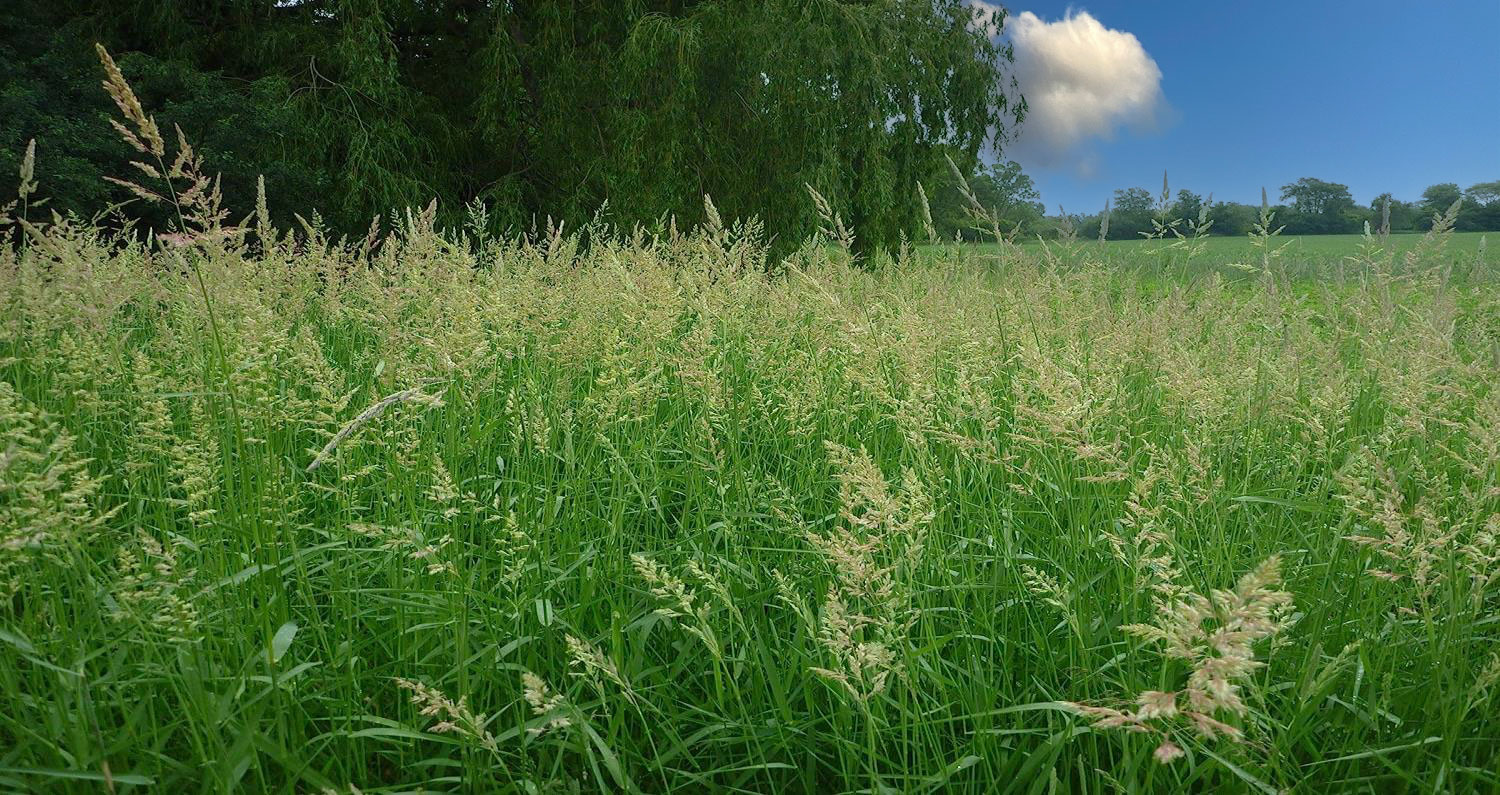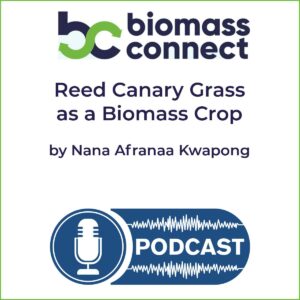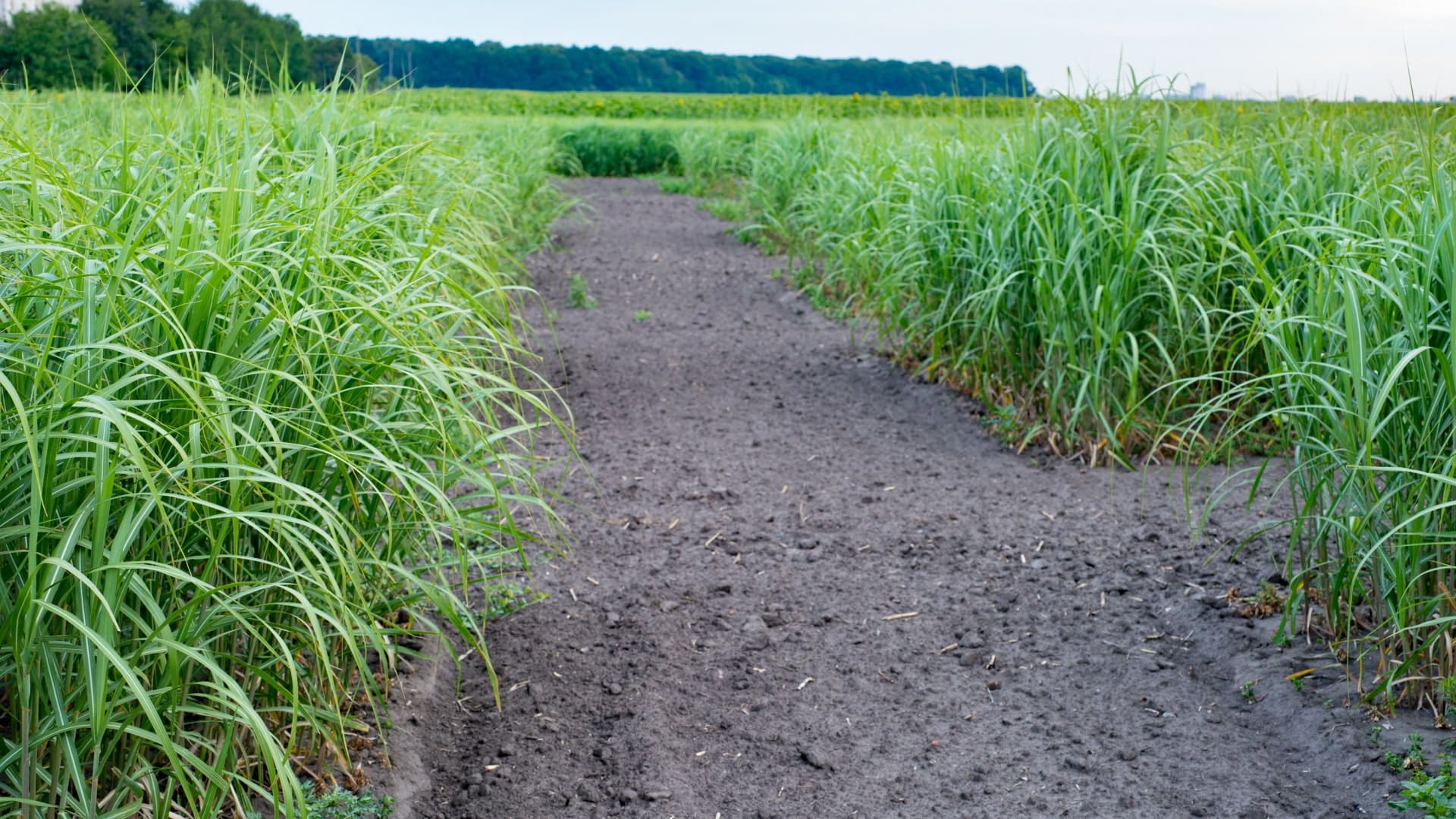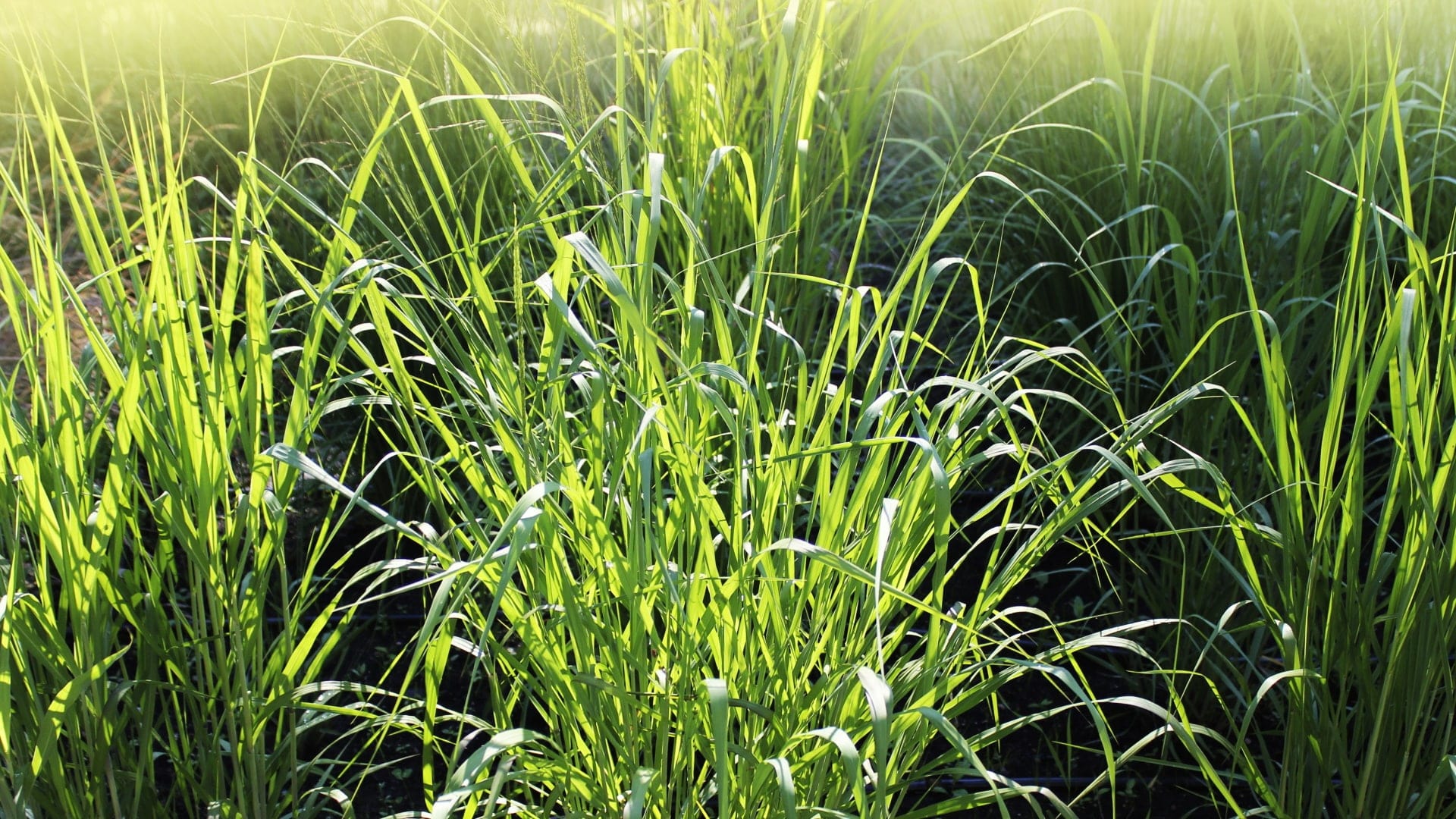Arundo
Arundo donax L.
General info
Originating from East Asia this water loving perennial plant grows in rich soils in water near lakes, ponds, marshes, rivers and other bodies of water to achieve its maximal biomass yield. Despite originating in East Asia it is now certified as being present in all inhabited continents across the globe suggesting a range of adaptabilities.
A. donax is a sterile plant able to reproduce asexually via its rhizomes which undergo exploratory expansion in the spring and summer or via rhizome fragments or rooting at the nodes. It ranges in height from around 2–9 m and undergoes this growth rapidly due to an unusually saturated photosystem for a C3 plant variety along with a development more associated with a C4 plant. It is one of the biggest herbaceous plants in the world which means it is productive as a bioenergy crop due to quick and large accumulations of biomass achieved.
In regions with warmer winters, it is evergreen but dies back in climates with freezing winter temperatures. However, it does produce biomass with significantly high moisture levels, which can be a complication for cutting, handling, conserving, storing and combustion processes. The moisture is more welcomed for ensiling based bioenergy production such as biogas production.
Cultivation and agronomy
A. donax plantations are said to produce biomass for around 10–15 years or even longer if harvested frequently and fertilised; though later harvest years tend to see a decline in biomass yields achieved. Similar to other rhizome species, it does require considerable soil restoration to reutilise the land for other planting aspects due to the need to ensure all rhizome is removed and destroyed to prevent re-establishment.
A. donax grows well with minimal inputs, though water requirements in the initial year of establishment can be crucial. Despite not needing fertiliser to thrive, productivity is increased when fertiliser is used. Like many other promising bioenergy grass-type crops, it is applicable to marginal lands which reduces competition with food production.
It has been reported to produce on average 30–40 Mg ha-1 dry matter per year with a significant range around this value (20–177 Mg ha-1), largely due to locally warmer climates in USA studies. It has outperformed both M giganteus and switchgrass (Panicum virgatum L.) in multiple studies, with above-ground dry biomass tonne ha-1 yr-1. Due to its large size, it may be a challenge for harvesting processes but it is suggested that slight modifications to machinery used for crops such as sorghum and corn can allow functional harvesting of A. donax.
Due to its halophyte nature, it is applicable to saline soils and can thrive in brackish estuaries. In the first establishing crop year, yields will be lower and more weed control will likely be needed via herbicide treatments. The sterility of this species makes it an interesting and controllable prospect as a bioenergy crops.
In energy production it appears to outperform traditional energy crops for bio-methane production (average 12,618 Nm3 CH4 ha-1) and, provided biomass pre-treatments are utilised, it also appears to outperform more energy crops with regards to bioethanol production (11,000 – 15,000 litre ethanol per ha-1). It delivers comparable direct combustion energies to those of miscanthus, poplar and switchgrass (18.7 MJ kg-1). As it has potential higher yields achievable than these species it is suggested that between 40–60% more energy could be produced per ha-1 via Arundo. Though, for direct combustion, it has been noted to have problematically high ash content compared to equivalents miscanthus and switchgrass but this could be resolved via timing of harvest, as earlier harvesting can reduce dry matter percentage of ash by more than twofold.
Return to crops overview
Relevant research
Corno, L., Pilu, R., & Adani, F. (2014). Arundo donax L.: a non-food crop for bioenergy and bio-compound production. Biotechnology advances, 32(8), 1535-1549.
Amaducci, S., & Perego, A. (2015). Field evaluation of Arundo donax clones for bioenergy production. Industrial Crops and Products, 75, 122-128.
Webster, R. J., Driever, S. M., Kromdijk, J., McGrath, J., Leakey, A. D., Siebke, K., … & Long, S. P. (2016). High C3 photosynthetic capacity and high intrinsic water use efficiency underlies the high productivity of the bioenergy grass Arundo donax. Scientific Reports, 6(1), 1-10.
Miscanthus
General info
Miscanthus is a perennial, rhizomatous grass native to Southeast Asia. The genus comprises multiple species of diverse morphologies, including ornamental grasses used in the UK for 100 years. More recently, the hybrid Miscanthus × giganteus was noted for its exceptional productivity. This led to trials in multiple European locations, where it has demonstrated high yields from low inputs across multiple environments, with annual harvests for up to 20 years from a single planting. M. × giganteus is a sterile hybrid of Miscanthus sinensis and M. sacchariflorus. These species and their hybrids have been identified as leading candidates for the provision of biomass for bioenergy and bioproducts.
Current markets in the UK predominate around heat and power, and high-quality animal bedding, but potential end uses are considerable, including the extraction of high value products. Other uses include packaging, reinforcing fibre for plastic or cement-based components, or as insulation.
Cultivation and agronomy
To date, establishment of Miscanthus has relied on sterile hybrids such as M. x giganteus, which are clonally propagated, generally from rhizome. Seed based hybrids that are established from plug plants offer an alternative establishment method and are currently being developed alongside other alternative clonal establishment methods, but rhizome remains the standard establishment method. Rhizomes are planted into land that has been ploughed and cultivated. It is important to limit competition from weeds in year 1 commonly through timely application of herbicides, but from year 2 onwards the requirement to manage weeds should be limited.
Miscanthus produces new shoots annually, emerging when soils warm in spring and forming erect, robust stems (similar to bamboo canes) reaching up to 3 metres or more in a mature stand. Miscanthus can be harvested annually from the second year, it is harvested in late winter once it has senesced and has dropped most of its leaves and can be harvested directly as chip or cut, swathed and baled. Full yield is not usually achieved until years 3-4 when the crop has established sufficient rhizome to produce a dense canopy that maximises light interception, and therefore yield. Average yield of well-established mature crops is 10-12 tonnes per hectare per year, and can reach up to 18 tonnes.
Return to crops overview
Relevant research
Clifton‐Brown, J., Harfouche, A., Casler, M. D., Dylan Jones, H., Macalpine, W. J., Murphy‐Bokern, D., … & Lewandowski, I. (2019).
Breeding progress and preparedness for mass‐scale deployment of perennial lignocellulosic biomass crops switchgrass, miscanthus, willow and poplar. Gcb Bioenergy, 11(1), 118-151.
Biomass Connect Trials
A Miscanthus varieties trial and a Miscanthus x giganteus trial are currently being grown as part of the Biomass Connect Project at the following hub sites
- AFBI Hillsborough
- BGI Chesham
- IBERS Aberystwyth
- NIAB Headley Hall
- Newcastle University Cockle Park Farm
- Rothamsted Research North Wyke
- SRUC Ayrshire
- SRUC Edinburgh
In addition, we have Miscanthus Athena growing at:
Reed Canary Grass
Phalaris spp. Phalaris arundinacea
General info
Reed canary grass is a multipurpose, lignocellulosic perennial crop native to Europe, Asia, and North America. It can be grown on poorly productive land and tolerates a wide range of conditions. Reed canary grass is found in diverse habitats including wetlands and riparian zones but also drier areas like roadsides, forest margins, pastures, and disturbed areas. It is a fast-growing crop reaching heights of 1.5-2 m in a growing season, and, depending on management, can remain productive for 5-10 years.
Cultivation and agronomy
Reed canary grass is planted by seed. It requires a firm, smooth seedbed and timely weed control during establishment, with fertilizer where nitrogen is limiting. Reed canary grass is highly tolerant to waterlogging (established stands can tolerate extended periods of inundation) and a wide pH range from pH4.9 to pH8.2. It can thrive on marginal land unsuitable for food or feed production. Once established, it is one of the most productive temperate grasses during drought due to its deep rhizome and root system. As a temperate grass used extensively in Scandinavia, it is also highly tolerant of freezing conditions.
Average yields of 5-7 tonnes per ha are achievable in the UK, depending on management. Harvesting can be conducted with conventional grass harvesting machinery and usually commences from the second year after sowing. The timing of harvest depends on the intended market/end-use. Forage quality is best in spring and early summer, while harvest for anaerobic digestion can extend from summer until autumn senescence begins. RCG disease levels are relatively low and are not considered a cause for concern. However, RCG can be attacked by insect larvae, which feed inside stem bases and can occasionally significantly reduce yield.
Return to crops overview
Relevant research
Landström, S., Lomakka, L., & Andersson, S. (1996). Harvest in spring improves yield and quality of reed canary grass as a bioenergy crop. Biomass and bioenergy, 11(4), 333-341.
Jensen, E. F., Casler, M. D., Farrar, K., Finnan, J. M., Lord, R., Palmborg, C., … & Donnison, I. S. (2018). Reed canary grass: from production to end use. Perennial Grasses for Bioenergy and Bioproducts, 153-173.
Additional Resources from Biomass Connect
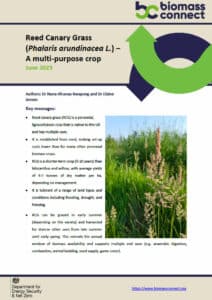
Read our Reed Canary Grass Technical Article
Take 5 minutes out of your day to listen to Dr. Nana Afranaa Kwapong talk about Reed Canary Grass as a Biomass Crop.
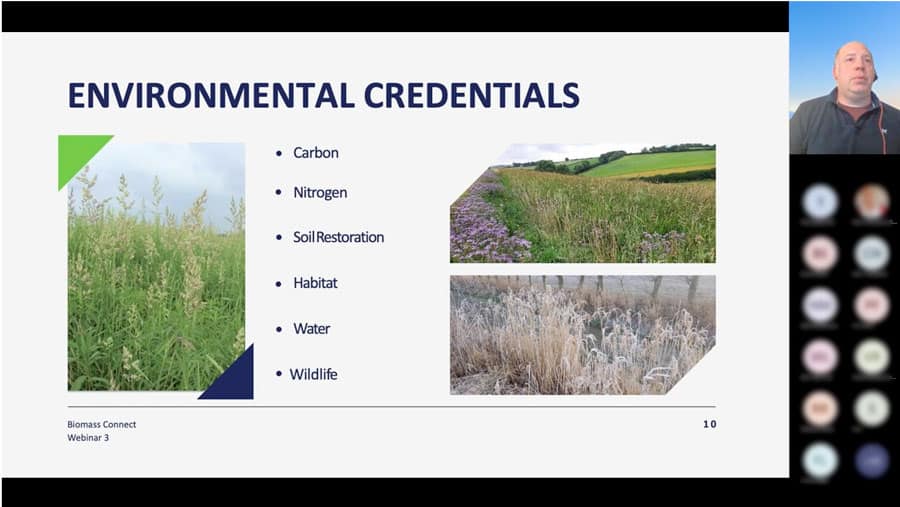
Watch John Hawkin’s Biomass connect webinar on Reed Canary Grass: Biomass Crops some Interesting Alternatives.
Switchgrass
Panicum spp – Panicum virgatum
General info
Switchgrasses are C4 perennial monoecious grasses native to North America with over 400 species within the genus. They are propagated by seeds and grow up to around 2.7 M in height. Similar to reed canary grass, switchgrass can also be incorporated into forage considerations for grazing (suitable for cattle only due to toxicities in other animals) and straw produced can be used for livestock bedding.
Attempts are being made to achieve domestication and commercial varieties of switchgrass via targeted breeding to enhance bio-energy quality varieties. Currently Transgenic approaches lead on this, with switchgrasses susceptible to transformation via agrobacterium, though overall this method of change is more costly than traditional breeding.
Cultivation and agronomy
Switchgrass has shown suggested yields of around 14 oven dried tonnes ha-1 y-1 with certain studies predicting yields up to 20 dried tonnes ha-1 y-1 in modelling scenarios rather than practical applications. It remains harvestable for 10–12 years before replanting considerations are needed. It is harvested annually using similar machinery to that commonly used for pasture activities.
The species has an extremely widespread distribution across Northern America due to its adaptable nature with multiple ecotypes being present. The two main ecotypes/cytotypes of interest, for their roles in incorporation into UK growth strategies and inclusion as bioenergy crops, are the upland and lowland ecotypes. The upland ecotypes are generally shorter and more cold-tolerant potentially having more applicability in the UK. However, the lowland ecotypes can achieve higher yields in the right environments, despite being more sensitive to stresses like moisture than their upland equivalents.
An important consideration with switchgrass species in the UK, is their apparent lower responsiveness to N fertilizer, yield increases seen on application of N were around half of those seen with similar bioenergy crop reed canary grass. As such, N fertilisation and environmental balances associated with these grass species, may need careful consideration in any bioenergy production strategy.
Return to crops overview
Relevant research
Smeets, E. M., Lewandowski, I. M., & Faaij, A. P. (2009). The economical and environmental performance of miscanthus and switchgrass production and supply chains in a European setting. Renewable and sustainable energy reviews, 13(6-7), 1230-1245.
Allison, G. G., Morris, C., Lister, S. J., Barraclough, T., Yates, N., Shield, I., & Donnison, I. S. (2012). Effect of nitrogen fertiliser application on cell wall composition in switchgrass and reed canary grass. Biomass and Bioenergy, 40, 19-26.
Clifton‐Brown, J., Harfouche, A., Casler, M. D., Dylan Jones, H., Macalpine, W. J., Murphy‐Bokern, D., … & Lewandowski, I. (2019). Breeding progress and preparedness for mass‐scale deployment of perennial lignocellulosic biomass crops switchgrass, miscanthus, willow and poplar. Gcb Bioenergy, 11(1), 118-151.
